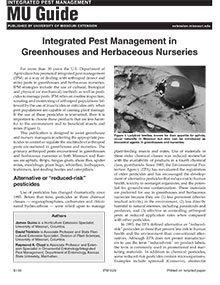

Food Defense: Protecting the Food Supply from Intentional Harm
New
Learn about food defense strategies to protect the food supply from intentional harm, including risk assessment, countermeasures, and emergency response plans.

Food Defense: Protecting the Food Supply from Intentional Harm, Page 2
New
Having a food defense plan for your operation can reduce the risk of intentional contamination to your operation and may ultimately benefit your bottom line.
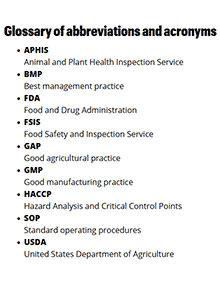
Food Defense: Protecting the Food Supply from Intentional Harm, Page 5
New
This glossary spells out abbreviations and acronyms related to food defense.
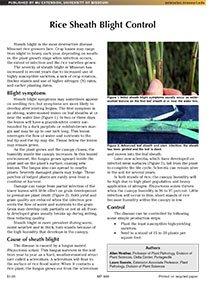
Rice Sheath Blight Control
Revised
Sheath blight is the most destructive disease Missouri rice growers face. Learn about sheath blight symptoms, causes and control; fungicide use; and scouting in this University of Missouri Extension guide.
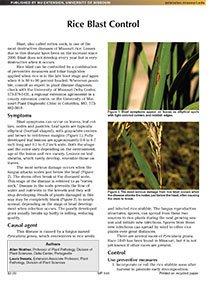
Rice Blast Control
Revised
Blast, also called rotten neck, is one of the most destructive diseases of Missouri rice. Learn about rice blast control in this University of Missouri Extension guide.

Cotton Disease and Nematode Management
Revised
Guide to identify and manage cotton diseases and nematodes with effective cultural, chemical and resistant variety strategies.
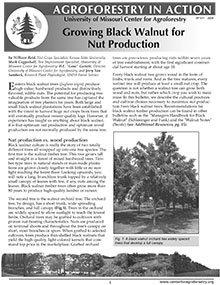
Growing Black Walnut for Nut Production
Revised
Editor's note
The following abstract describes a publication that is only available as a downloadable PDF.

Understanding and Encouraging Your Young Child’s Large Motor Development
Reviewed
Learn how to support your child's large motor development with age-specific milestones and activity suggestions from birth to age six.

Challenges and Choices: Family Health
Reviewed
This guide helps families manage common illnesses, recognize when to seek medical care, and make informed health decisions at home.


Homebuyer’s Resource Guide: Home Ownership Made Easier
Reviewed
Do you dream about living in your own home someday?

Challenges and Choices: Emotional Well-Being—Women’s Self-Esteem
Reviewed
This guide explores how women perceive themselves across various life roles and offers strategies to enhance self-worth.

Keeping the Roof Over Your Head, A Consumer Guide to Homeowners Insurance
Revised
Learn about homeowners and renters insurance, policy types, coverage options, and tips for selecting the right insurance to protect your home and belongings.

Cambio de Colores — Latinos in Missouri: Conference Abstracts 2006-2008
New
Abstracts and papers from 2006–2008 conferences highlighting Latino community integration, education, health, and economic development.
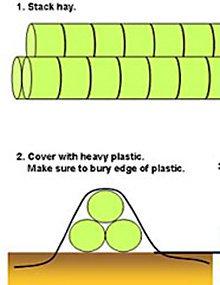
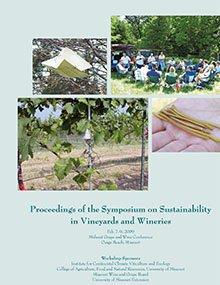
Proceedings of the Symposium on Sustainability in Vineyards and Wineries
New
Editor's note
The following abstract describes a publication that is only available as a downloadable PDF.

Practical Horse Psychology
Revised

Spreading Poultry Litter With Lab Analysis But Without Soil Tests
Reviewed
Learn how to manage poultry litter as a fertilizer while minimizing environmental impact and fulfilling regulatory requirements.
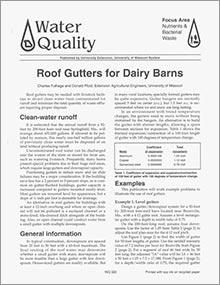
Roof Gutters for Dairy Barns
Reviewed
Learn how to install roof gutters on dairy barns to manage clean water runoff, reduce waste, and prevent contamination.

Selecting and Working With an Engineering Consultant to Design Animal Waste Management Facilities
Reviewed
Guidance for livestock producers on hiring engineers to design compliant animal waste systems under Missouri DNR regulations.
Rules for Missouri Fourth-Class Cities - Page 15
New
Cities must establish personnel policies, maintain accurate records, and comply with wage laws, including compensatory time and overtime regulations.
Rules for Missouri Fourth-Class Cities - Page 18
New
Explore bond options for Missouri's fourth-class cities, covering general obligation and revenue bonds, voter requirements, interest rates, and loan terms.
